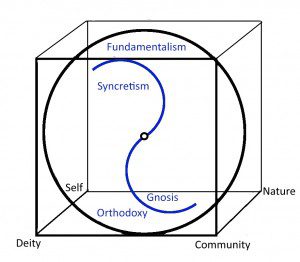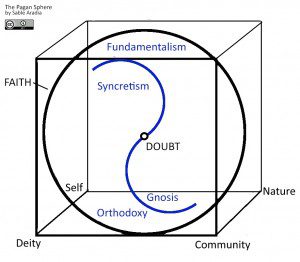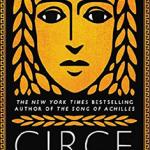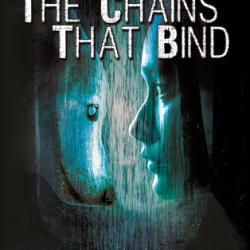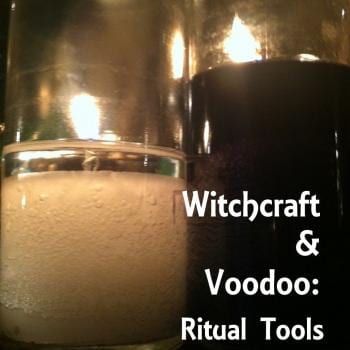Part Six: The Big Tent Revisited
Let’s go back to our diagram. Here in our cube we have the Four Centers of Paganism; here in our sphere we have shifting winds that churn back and forth between these magnetic poles.
So now we come to the hard questions.
What are we doing here? What is the purpose of this conference? What is Paganism?
You know what I think? I think that as long as you’re flying around in this sphere somewhere, you’re a Pagan. That generally means you’re growing and changing between the four poles. You rise and fall on the air currents between Syncretism and Fundamentalism, Gnosis and Orthodoxy. You might be really close to one pole and really far away from another. But if you’re thrown out of the sphere by the force of the current you’re on, or pulled out by one of the poles, then you might not be a Pagan anymore.
There’s a movement happening in which some Polytheists are telling us that they aren’t Pagans. They are something different but related. Well, have they flown right out of the sphere? Maybe they’re right.
And there’s nothing wrong with that! It’s a big tent, but it can’t cover everybody. Hindus are related to us – my sister-in-law married into a Hindu family and the priestesses and my husband and I had a chance to chat about faith; as far as they were concerned we might as well be Hindus – but we’re not Hindus and they’re not Pagans. On the other hand, some of the Afro-Diasporic faiths are starting to tell us that they are Pagans when we didn’t have a lot of contact before, and I think that they are indeed. Part of that is decided by whether or not a group self-identifies as Pagan. But part of it isn’t. Part of it is about having enough in common with the group that others identify you.
Part Seven: The Nexus
So what’s at the center of the hub? What’s the galactic core of this crazy structure that we keep whirling and swirling around? I’ve got a theory. It’s this:
DOUBT
In a way, Paganism is the natural conclusion of the Reformation. Protestants rejected Catholic dogma and came up with a novel idea: not by the power of any overseeing authority, but by the power of one’s own faith, one finds salvation. Paganism goes one step further. We say that faith is necessary, but everyone’s faith is individual.
The only way in which this crazy storm of weirdness can exist; the only way by which we oddballs can get along with one another, is to realize that each one of us might be wrong. Or, more importantly, that each one of us might be right. We need to accept that truth depends a great deal upon one’s point of view. This is more than just license to pursue one’s own relationship with the gods and nature as one sees fit. It is also an admonishment not to dismiss the opinions of others out of hand just because you don’t agree. More than that, we have to accept that contradictory “truths” may be true at the same time; and we also have to accept that what is right and perfect for me may be completely wrong for someone else. We have no right to enforce our opinions on others. We do have the right to use our discernment.
I’ve had some pretty intense Gnostic experiences. I have seen beings that I believe to be gods and I have had some intense visions. I believe in them for myself. But I also accept that they might just be “bits of undigested beef.” I’m married to a schizophrenic; hallucinations are just as real to a schizophrenic as you and I are. I believe in reincarnation; but I don’t think it works the way that others do and I accept a whole host of other possible explanations for the experiences that have inspired this belief. I believe I’ve done magick that has had potent and measurable results in the real world. But I also realize it could all be the placebo effect and confirmation bias. Furthermore, I believe different things on alternate Tuesdays and I believe whatever I have to for long enough to make the ritual work. And I have seen these rifts in the community do their best to tear it apart arguing about it.
Do you want to hear about the most valuable Gnosis I think I’ve ever received?

It was December 21, 2010. The Full Long Night’s Moon fell on Midwinter Night, and I had a dream. In this dream, I looked up at a stack of books that wound in a haphazard pile up to the ceiling of my house and through a trapdoor to an attic. I had a sense that I had to get to the top of the pile, so I started to climb the stack. I realized that there were all types of books in the pile; old hardcovers with no title save the gilding on the side, magazines, paperbacks, trade paperbacks, new hardcovers with fancy book jackets. When I reached the top and went through the attic, I was in a different house; all white walls and minimalist art in an upper middle class style.
The stack meandered through a skylight into a library of the old-fashioned sitting-room type, up to another skylight. I climbed up through that one, and found myself in a teepee, climbing up through the firepit and into the smoke hole. On the other side of that was a Mongol yurt; on the other side of that was a little apartment with peeling green paint. Then there was a Buddhist temple and a Gregorian monastery, an old lady’s apartment filled with doilies, and a college dorm.
Up through probably twenty or thirty different dwellings I climbed and climbed. The last one was a crowded camper of the sort that fits on the back of a pick-up, and the books finally ended at one of those upper level shelves that hold a camper’s bed. On the sleeping bags was an old TV, of the sort that still had rabbit-ears and a bubble screen and a UHF dial. It came to life as I approached and passed quickly from snow to an image. It was Pan, in His full glory with His hairy goatee and His curly goat horns and His intense black eyes. “You wanna know the truth?” He said. “Well, here it is: there is no truth. You make your own truth. Do with that what you will.”[xxi]
If you can’t accept that – if you really believe that you have THE TRUTH – maybe you aren’t Pagan anymore. That’s where I draw the line; if you’re anywhere in this sphere, centered on this nexus point, then you’re a Pagan to me. Just as I believe that as long as you’re willing to embrace a democratic process, uphold the Charter, be polite, swear to the Queen and respect your neighbours, I don’t care what language you speak, what country you came from, or what your race, sexual preference or religion is; you’re a Canadian.
When I sat down to write this and I was trying to come up with what in the world I was going to talk about, I was really nervous. I’m not an academic. I don’t have a background in public speaking. I’ve never done anything quite like this before. So my partner said to me, “If you had the most influential Pagans in the country all in one room, what would you say to them?”
I would say that I believe that the core of Paganism – the key to reawakening our shared theology – is this: Your Mileage May Vary.[xxii]
Thank you.
[i] Source: Dictionary.com http://dictionary.reference.com/browse/theology?s=t, accessed May 10, 2015.
[ii] Ibid.
[iii] Halstead, John. “The Three (or more?) ‘Centers’ of Paganism.” The Allergic Pagan http://www.patheos.com/blogs/allergicpagan/2012/05/23/the-three-or-more-centers-of-paganism/, May 23, 2012.
[iv] Beckett, John. “The Four Centers of Paganism.” Under the Ancient Oaks: Musings of a Pagan, Druid and Unitarian Universalist http://www.patheos.com/blogs/johnbeckett/2014/05/the-four-centers-of-paganism.html, May 28, 2014.
[v] Beckett, John. “The Big Tent of Paganism.” Under the Ancient Oaks http://www.patheos.com/blogs/johnbeckett/2015/01/the-big-tent-of-paganism.html, January 11, 2015.
[vi] Dictionary.com http://dictionary.reference.com/browse/humanism?s=t, accessed May 10, 2015.
[vii] Ibid.
[viii] Myers, Brendan, Ph.D. The Other Side of Virtue: Where Our Virtues Come from, What They Really Mean, and Where They Might Be Taking Us (2008). John Hunt Publishing Ltd., Alresford, Hants, UK.
[ix] Cuhulain, Kerr. Full Contact Magick: A Book of Shadows for the Wiccan Warrior (2002, 2004). Llewellyn Publications, St. Paul, MN, U.S.A.
[x] Free, Esra, HPs. Wicca 404: Advanced Goddess Thealogy (2007). New Paradigm Press, U.S.A.
[xi] Myers, Brendan, Ph.D. A Pagan Testament: The Literary Heritage of the World’s Oldest New Religion (2008). John Hunt Publishing Ltd., Alresford, Hants, UK.
[xii] Hutton, Ronald. The Triumph of the Moon: A History of Modern Pagan Witchcraft (1999). Oxford University Press, Oxford, UK.
[xiii] Dictionary.com http://dictionary.reference.com/browse/syncretism?s=t, accessed May 10, 2015.
[xiv] Gardner, Gerald. Witchcraft Today (1954). Rider and Company, UK.
[xv] Aradia, Sable. “Wicca: A Syncretic Faith.” Between the Shadows: the Craft of a Liminal Witch http://www.patheos.com/blogs/betweentheshadows/2014/11/wicca-a-syncretic-faith/, November 15, 2014.
[xvi] Hutton, Ronald. The Triumph of the Moon.
[xvii] Dictionary.com http://dictionary.reference.com/browse/fundamentalism?s=t, accessed May 10, 2015.
[xviii] Dictionary.com http://dictionary.reference.com/browse/orthodox?s=t, accessed May 10, 2015.
[xix] West, Asa. “Jewish Witch: I Have Conversed with the Morrigan About Gaza.” Agora http://www.patheos.com/blogs/agora/2014/08/jewish-witch-i-have-conversed-with-the-morrigan-about-gaza/, August 12, 2014.
[xx] Reference to the fictional Forgotten Realms Dungeons & Dragons universe, which includes the work of several writers. (1990-2015) Wizards of the Coast LLC.
[xxi] Aradia, Sable. “Your Mileage May Vary – Embracing Contradictory Truths in the Craft.” Agora http://www.patheos.com/blogs/agora/2013/11/seekers-and-guides-your-mileage-may-vary-embracing-contradictory-truths-in-the-craft/, November 25, 2013.
[xxii] Ibid.
Like us on Facebook at the Patheos Pagan Facebook page or the Between the Shadows Facebook page.

